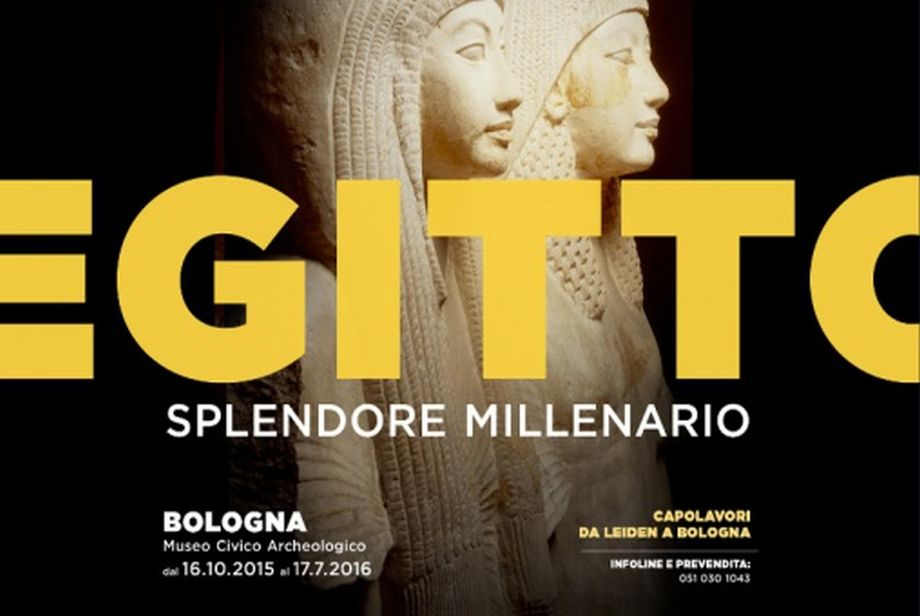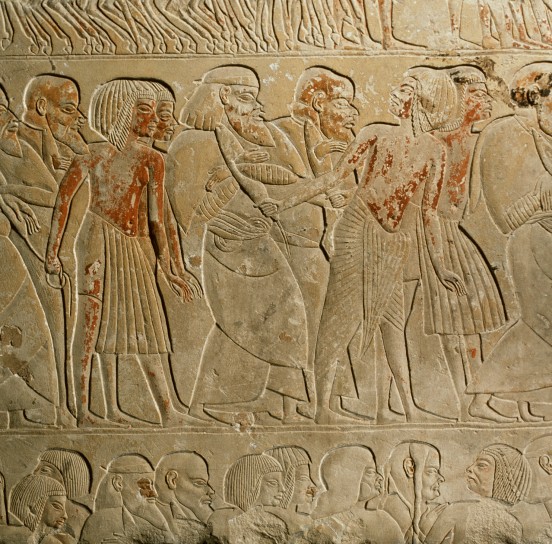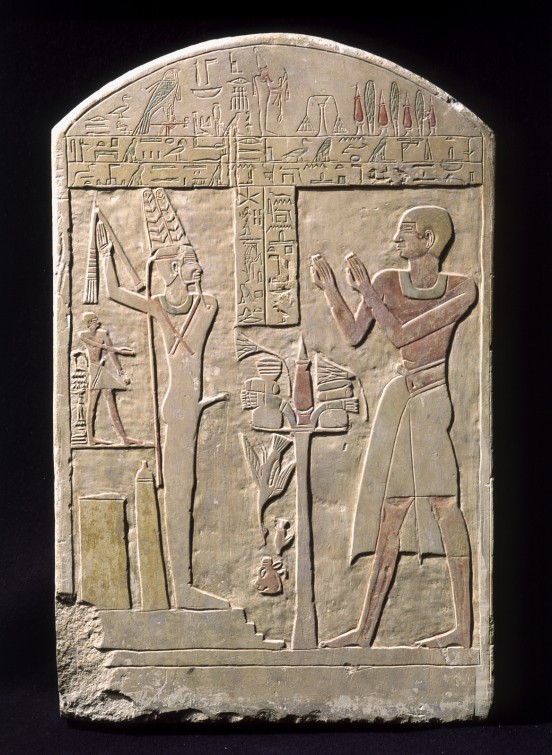The Museo Civico Archeologico is hosting Egypt. Millennia of Splendour. Beneath the two towers, the splendour of a civilisation that lasted thousands of years and has always fascinated the entire world, has sprung back to life: the Egypt of the pyramids, pharaohs and multiform gods, but also that of sensational discoveries, captivating archaeology, passionate collecting and rigorous scholarship.

The exhibition ‘Egypt’, which is being held at the Museo Civico Archeologico in Bologna, is not just an exposition of high visual and scientific impact, but also an unprecedented international enterprise: the Egyptian collection of the National Museum of Antiquities in Leiden, Netherlands – among the top ten in the world – and that of the Bologna museum – among the most important in Italy for the quantity, quality and state of conservation of its collections – have been brought together in an exhibition space measuring around 1,700 metres, filled with art and history.
500 finds, dating from the Pre-Dynastic Period to the Roman Period, gave been brought from the Netherlands to the Bologna museum. And, together with the masterpieces from Leiden and Bologna, the exhibition also includes important loans from the Museo Egizio in Turin and the Museo Egizio in Florence, creating a network of the most important Italian museums.
For the first time, the masterpieces of the two collections are being displayed side by side, including the Stele of Aku (Twelfth–Thirteenth Dynasty, 1976–1648 BC), the ‘major domo of the divine offering’, with a prayer describing the otherworldly existence of the deceased in a tripartite world divided into sky, earth and the beyond; gold items attributed to General Djehuty, who led the Egyptian troops to victory in the Near East for the great conqueror Pharaoh Thutmose III (1479–1425 BC); the statues of Maya, superintendent of the royal treasury of Tutankhamen, and Merit, a chantress of the god Amun, (Eighteenth Dynasty, reigns of Tutankhamen and Horemheb, 1333–1292 BC), the most important masterpieces in the National Museum of Antiquities in Leiden have left the Netherlands for the first time for the Bologna exhibition; and, among the numerous objects attesting to the refined lifestyle of the most wealthy Egyptians, a Mirror Handle (1292 BC) in the shape of a young woman holding a small bird in her hand.

and Horemheb (1319 – 1292 BC) [Credit: Museo Civico Archeologico, Bologna]
Lastly, for the first time 200 years after the discovery of his tomb in Saqqara, the exhibition offers the unique and once-in-a-lifetime opportunity to see the important Reliefs of Horemheb reunited: Horemheb was the head commander of the Egyptian army during the reign of Tutankhamen, then rising to become the final sovereign of the Eighteenth Dynasty, from 1319 to 1292 BC and the reliefs are divided between the collections in Leiden, Bologna and Florence.
Thousands of years of the history of a unique civilisation revealed in a major exhibition that brings together masterpieces from important world collections and tells of the pyramids and pharaohs, the great captains and priests, the gods and other divinities, and the people that made Egyptian history and that, thanks to discoveries, archaeology and collecting, never stop enchanting, revealing, intriguing, fascinating and charming generation after generation.
The Seven Exhibition Sections
The Pre-Dynastic and Archaic Periods – At the Origins of History: The transition from raw material to form, from the oral tradition to the written one and from prehistory to history was a fundamental moment for Egyptian civilisation. The Leiden collection is rich in materials documenting the central role played by nature during this long cultural and artistic evolution.

[Credit: Museo Civico Archeologico, Bologna]
The exhibition opens with a selection of these objects, which are strikingly modern in style, including a vase from the Naqada IID Period (named for a site in Upper Egypt and datable between 3375 and 3325 BC) decorated with ostriches, hills and water motifs. The scene depicted on this vase takes us back to an Egypt characterised by a flourishing landscape later changed over time by climatic changes. Ostriches, here painted red, along with elephants, crocodiles, rhinoceros and other wild animals were common in the Nile region at the time.
The Old Kingdom – A Political/Religious Model Destined for Success and its Weaknesses: The historic period of the Old Kingdom (from the Third to the Sixth Dynasty, roughly between 2700 and 2192 BC) is known for the pyramids and for the consolidation of a bureaucracy at the apex of which stood an absolute sovereign, considered a god on earth and lord of all of Egypt.
This definition of State and its worldly and otherworldly rules, which were highly elitist, are well documented by funerary objects, of which the Leiden museum has a particularly rich collection, including a calcite (alabaster) table for offerings.
Offerings to the deceased were a fundamental part of the funerary ritual, ensuring life after death. The uniqueness of this table, which belonged to a high state official named Defdj, lies in its circular shape, which was unusual, as well as the repetition of the concept of the offering as indicated by the inscription, the sculpted receptacles and, most importantly, the central depiction corresponding to the hieroglyph hotep (offering), or a table upon which one places a loaf of bread.

[Credit: Museo Civico Archeologico, Bologna]
The Middle Kingdom – The God Osiris and a New Perspective on Life in the Afterworld: The end of the Old Kingdom and the period of political breakdown that followed it led to major changes in Egyptian society, within which the individual had greater responsibility for his own destiny, including in the afterworld. Any Egyptian with the means to build a tomb complete with a sufficient funerary assemblage could now aspire to eternal life. The god Osiris, lord of the afterworld, became Egypt’s most popular divinity.
Many steles now in Leiden and Bologna came from his temple in Abydos, one of Egypt’s most important cult centres. Among them is that of Aku, major domo of the divine offering, who dedicated the stele to Min-Hor-nekht, the form of the ithyphallic god Min worshipped in the city of Abydos. Aku’s prayer to the god describes an otherworldly existence in a tripartite world: the sky, where the deceased were transfigured into stars, the earth, where the tomb was the fundamental point of passage from life to death, and the beyond, where Osiris granted the deceased eternal life.
From the Middle to the New Kingdom – Territorial Control at Home and Abroad: The defeat of the Hyksos, ‘princes from foreign lands’ who invaded and governed northern Egypt for a few generations, marked the beginning of the New Kingdom. An extremely aggressive foreign policy enriched Egypt, and this was one of its periods of greatest splendour. The social class of professional warriors rose to the top of the state hierarchy and spawned a number of ruling dynasties.

XVIII Dynasty, reign of Tutankhamun (1333 – 1323 BC)
[Credit: Museo Civico Archeologico, Bologna]
The wealth and prestige of these soldiers was also expressed in the production of sophisticated objects, including the gold items attributed to Djehuty, a general under the pharaoh Thutmose III. The Egyptian goldsmith’s art has survived in works of high artistic and economic value, an example being the pectoral element on view in the exhibition.
This piece is a sophisticated exemplar attributed to the tomb of General Djehuty, the man to whom the sovereign Thutmose III entrusted control of his foreign territories. Representing a blue lotus flower, a symbol of rebirth and regeneration, it must have served as the central element of an elaborate pectoral. The scroll engraved on the back suggests that the piece was given personally by Thutmose III.
The Saqqara Necropolis of the New Kingdom: The Leiden and Bologna museums can be considered ‘twins’ in a certain sense, since they house two important groups of antiquities from Saqqara, one of the necropolises of the city of Memphis. During the New Kingdom, this early Egyptian capital returned to its role as a strategic centre for the expansionist policy of the sovereigns of the Eighteenth Dynasty.
This is seen in the funerary monuments of high state officials who held administrative, religious and military roles, including the tombs of the superintendent of Tutankhamen’s royal treasury, Maya, and his wife, Merit, chantress of Amun, and that of Horemheb, head commander of Tutankhamen’s army and the pharaoh’s crown prince.

[Credit: Museo Civico Archeologico, Bologna]
The statues of Maya and Merit arrived in the Netherlands in 1829 as part of the collection of Giovanni d’Anastasi. More than a century and a half would pass before, in 1986, a British/Dutch archaeological expedition identified the tomb from which they came, southeast of the pyramid of Djoser at Saqqara. These statues, which are the greatest masterpieces in the collection of the National Museum of Antiquities in Leiden, left the Dutch museum for the first time to be displayed in the exhibition.
It should be noted that, when the Egypt Exploration Society of London and the National Museum of Antiquities in Leiden began excavation work southeast of the Djoser pyramid in 1975, the goal was to find the tomb of Maya and Merit. It was therefore a great surprise when they instead discovered the burial of General Horemheb, who had capped off his stunning career by becoming the last sovereign of the Eighteenth Dynasty.
His tomb, which has a temple structure, is characterised by a pylon entrance, three large courts and three cult chapels facing onto the innermost court, which has a peristyle structure. This court is where most of the reliefs preserved in Leiden and Bologna were found, narrating Horemheb’s most important military feats against the populations bordering Egypt: the Asians, Libyans and Nubians.
The New Kingdom – Prosperity after the Conquest: Refined furnishings, musical instruments, table games and jewellery: these are just a few of the luxury goods attesting to the widespread prosperity enjoyed in Egypt as a result of the expansionist policy of the sovereigns of the New Kingdom. Through these sophisticated objects, it is possible to conjure up moments of everyday life, imagining what it was like living inside a royal palace or the residence of a high official. One example in the exhibition is a mirror handle in the graceful, sensual shape of a young women holding a small bird in her hand.

[Credit: Museo Civico Archeologico, Bologna]
Egypt in the First Millennium: In the first millennium BC, Egypt was characterised by the increasingly clear weakness of its central power to the advantage of local governors who gave themselves the role of ruling dynasts. The loss of political and territorial power weakened Egypt’s defence capacity at its borders, opening the way for Nubian, Assyrian and Persian invasions. The temples remained strong centres of power, and managed a sizeable portion of the economy and the transmission of knowledge, taking on the role of a political intermediary between the ruling power and the devout populace.
Many of the masterpieces on view in the exhibition were part of the funerary assemblages of priests and came from important temple areas. Among them is the sarcophagus of Peftjauneith, which represents the likeness of the god Osiris, wrapped in a linen shroud and with a green face evoking the concept of rebirth. The refined decoration of this sarcophagus confirms the high rank of its owner (the superintendent of the possessions of a temple in Lower Egypt) in the temple sphere. Of particular note is the interior scene of the sky goddess Nut swallowing the sun every evening (to the west) to then give birth to it in the morning (to the east).
Alexander the Great’s conquest of Egypt in 332 BC ended the ‘pharaonic’ phase of Egyptian history. The period of Greek domination was begun by his successors, the Ptolemies, the last of whom was the renowned Cleopatra VII.
The golden decline of Egypt would continue for many more centuries, beyond the Roman conquest in 31 BC up to Arab domination in the sixth century AD.
The dialogue between old and new, local and foreign that distinguished the Greco-Roman period brought a return to high artistic achievements, including the celebrated Fayum portraits, exquisite examples of which from the Leiden collection are on view in the exhibition
Source: Museo Civico Archeologico in Bologna [October 19, 2015]